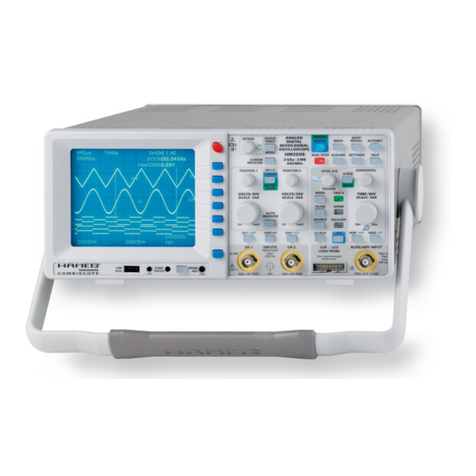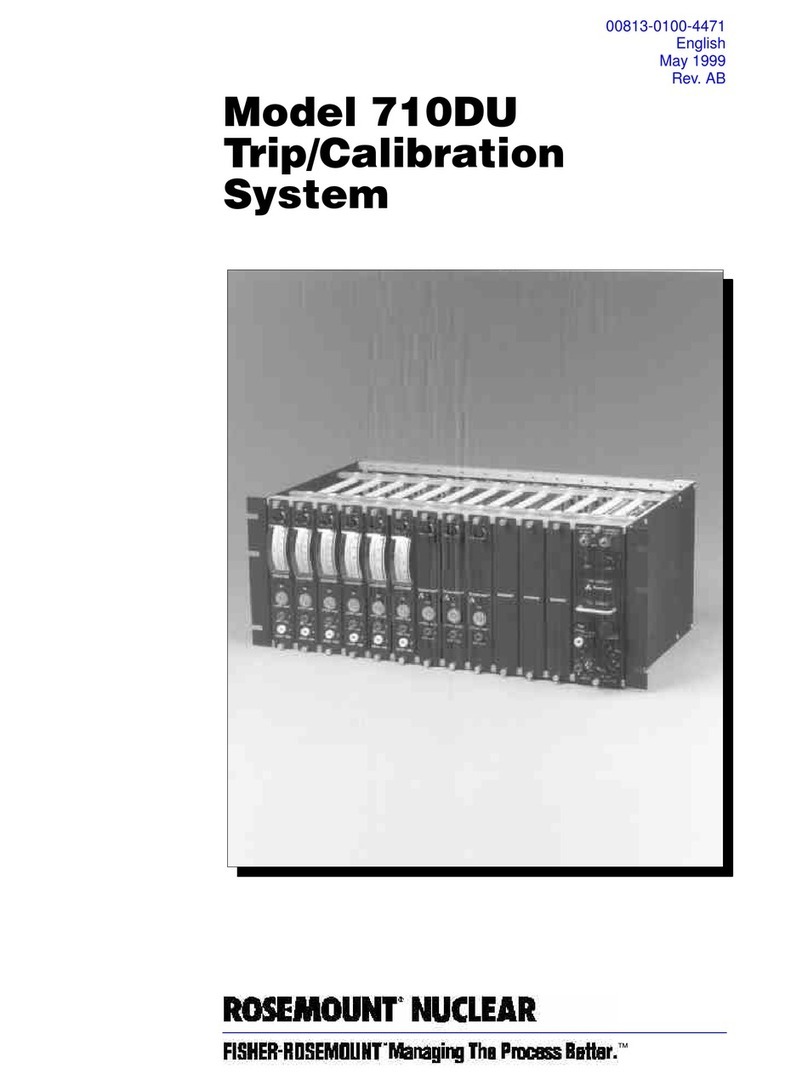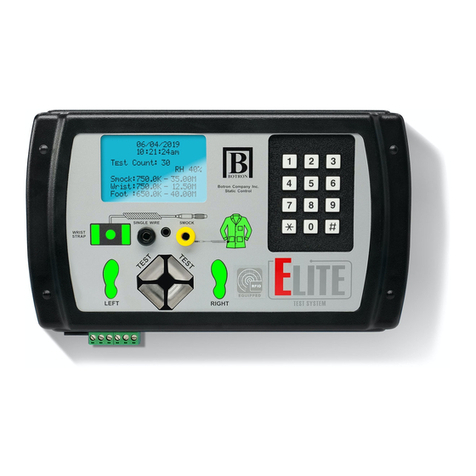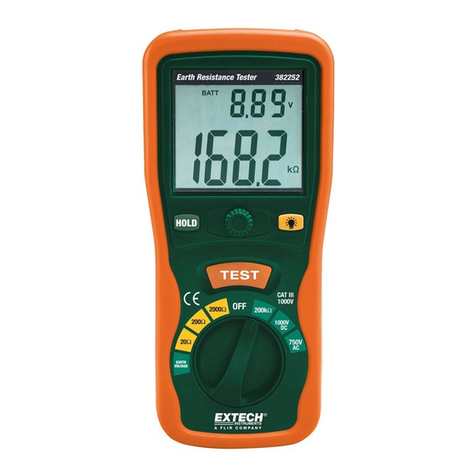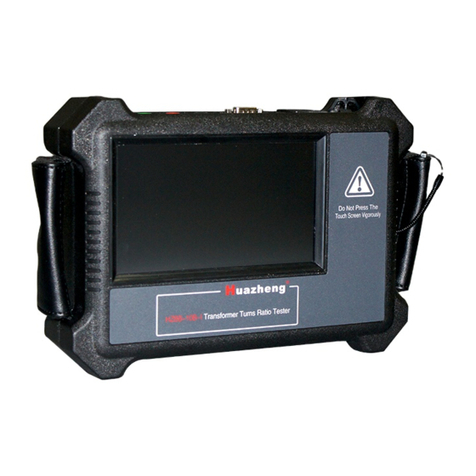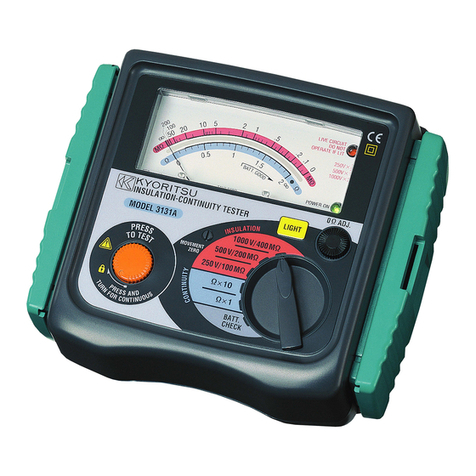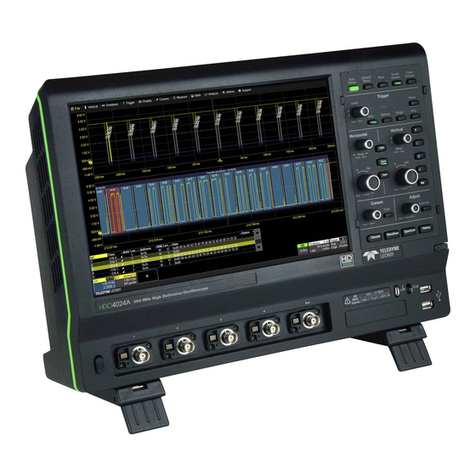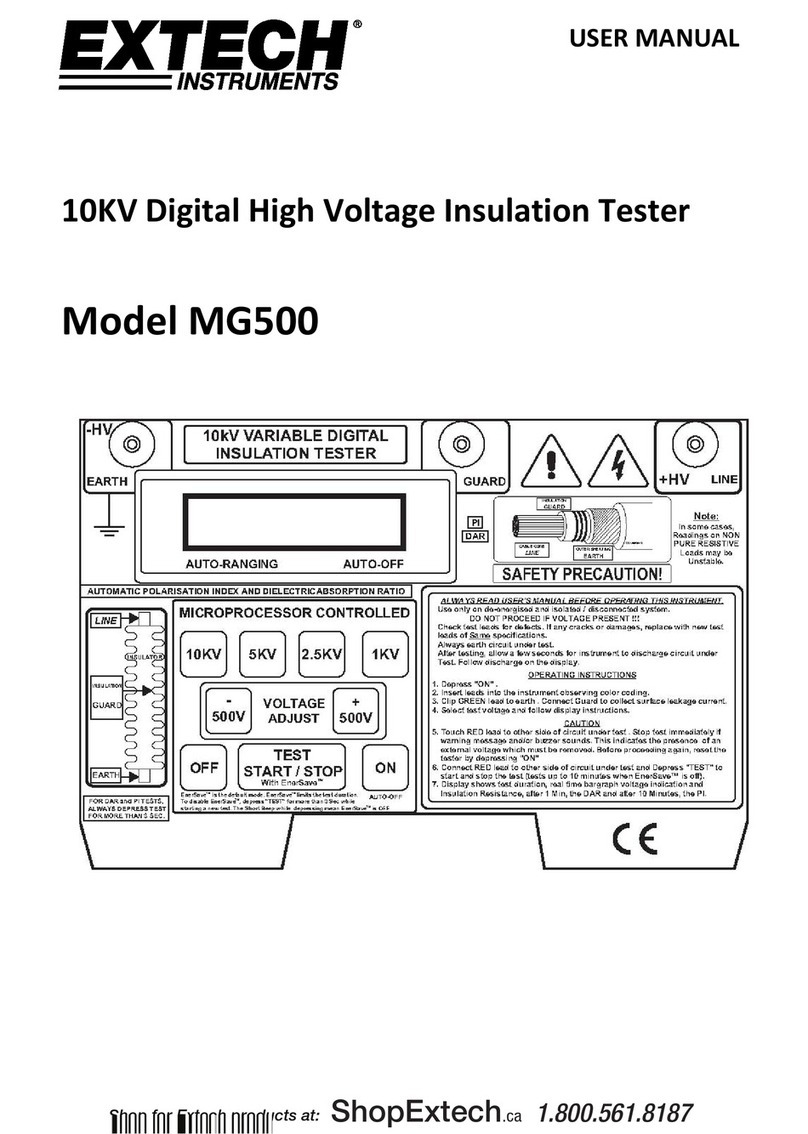Sincro DG83-D User manual

INSTRUCTION MANUAL
INSTRUCTION MANUAL
FOR STROBOTESTER
FOR STROBOTESTER
MOD.
MOD. DG83-D
DG83-D
© Copyright by SINCRO 2007
Nessuna parte di questo manuale può essere
riprodotta senza l’autorizzazione scritta del
proprietario.
None of the parts of this manual can be repro-
duced without the written authorization of the
owner.
Edition of October 19, 2011
Informazioni
Via G. P. Sardi, 24/A - 43100
Alberi - PARMA - ITALY
+39-0521 - 648293 (713)
+39-0521 - 648382
http://www.sincro.com

- 2 -
CZ sincro DG83 D
CHAPTER TITLE PAGE
Disposal (Directive 2002/96/CE (WEEE))
– When you wish to break up the unit, detach the electrical, electronic, plastic and iron parts.
– Proceed to the separated disposal foreseen by the regulations in force.
Index
1.0 FOREWORD ......................................................................................................................... 3
1.1 technical features ............................................................................................................... 3
1.2 warnings ........................................................................................................................... 3
2.0 PRELIMINARY INFORMATION ............................................................................................... 4
2.1 display .............................................................................................................................. 5
2.2 commands position ............................................................................................................ 5
2.3 optional adapters ............................................................................................................... 5
3.0 ADVANCE MEASUREMENTS .................................................................................................. 6
4.0 CHECKING IGNITION SYSTEM PERFORMANCE ...................................................................... 8
5.0 MEASUREMENT OF INJECTION TIME ................................................................................... 10
6.0 VOLTAGE MEASUREMENTS ................................................................................................. 11
7.0 STROBOSCOPIC RPM COUNTER.......................................................................................... 13
SETTING FOR MEASUREMENTS .................................................................................................... 14

- 3 -
CZ sincro
DG83 D
The strobotester DG83 D was conceived by SINCRO for checking stroboscopic advance and
diagnostic checks on conventional and Gdi petrol engines
RPM and advance measurements can be switched on the display by a key in the handgrip,
they are independent from the number of cylinders and can be carried out on distributor
ignition systems, DIS and coil per plug systems.
Through a key in the rear side of the strobotester it is possible to measure time and duty cycle
of actuators in percentage, direct and peak voltages of sensors and actuators, battery voltage
at cranking, alternator’s charging voltage and RPM by stroboscope without applying any
reflectors.
The present features satisfy the requirements of technicians and workshops which require
high quality.
1.1 TECHNICAL FEATURES
MEASUREMENTS READINGS RESOLUTION
–
RPM
400 ÷19999 revs/min. 10 revs
–
RPM by stroboscope
60 ÷6000 revs/min. 10 revs
–
Ignition advance
0÷78°up to 480 RPM
–
Ignition advance
0÷90°from 465 to 19990 RPM 0.1°.
–
Dwell in milliseconds
0÷262 ms 0.1 ms
– Dwell in percentage 0÷100% 0.1%
– Dwell in degrees (each cam) 0÷360°(> 460 RPM) 0.1°
–
DC Voltage
1÷70 Volt 0.1 Volt
–
Peak Voltage
1÷70 Volt 0.1 Volt
–
Memory of reading 6 sec. from key D release
–
Power supply
9.5÷15 Volt (9.5÷35 V optional)
1.0 FOREWORD
1.2 WARNINGS
•Do not wind cables around the unit.
•Do not drop the unit or the inductive clamp.
•Do not use solvents or gasoline to clean plastic parts.
•During use keep cables away from exhaust pipes or rotating parts.
•To set different engines, systems or measurements, follow the instructions of the relevant
chapters.
•Lack of signals from the inductive clamp or from the TL220 cable are shown by a
blinking zero on display 1 and 3(Fig. 1).

- 4 -
CZ sincro DG83 D
2.0 PRELIMINARY INFORMATION
•For the right use of the strobotester, it is necessary to become familiar
with commands and to know some preliminary instructions.
The following chapters contain detailed instructions, while the yellow
sheets contain short form instructions.
•Fig. 1 shows the displays and the keys for selecting measurements.
Special LEDs show the default setting after connecting the unit to
battery as well as the type of measurement selected by the operator.
• Blinking zero shows lack of electrical signal
•The keys in the handle of Fig. 2 are normally used to adjust advance,
activate flash, switch and store measurements.
They can also have different functions, described in the relevant
chapters.
•RPM and ignition advance measurements are carried out by connecting
the inductive clamp to the spark cable of cylinder No. 1 and are
independent from the number of cylinders.
•Readings of injection time, ignition coil charging time, Duty Cycle of
actuators and Dwell in degrees in points systems, are displayed on
display 3 (chap. 4,5,6). See par. ATTENTION on page 7 for checking
the wear of each cam.
•Select the number of sparks per revolution, really existing (Table 1) to
have correct readings.

- 5 -
CZ sincro
DG83 D
V
24
RESET
STROBOTESTER DG 83-D
min.
V=
C –C +
TDC MARKS ALIGNER
TL17 Cables for ground connections
AD 33A Needle for picking up signals
Fig.1
2.1 DISPLAY
2.2 COMMANDS POSITION
2.3 OPTIONAL ADAPTERS
Key C +/–
Adjust
Selection
D key
Flashing
Memory
Switching
Confirmation
TL 220 Advance/Volt/
Dwell cable
Fig.2
LED 1 RPM
Display
RPM, Advance, Dwell, Volt
Volts /Dwell in milliseconds /
percentage / degrees
LED 4
Direct and peak voltage
LED 2
Advance
Spark/rev.
selection
Reset of the unit
2/4
Strokes
TL 200 Power supply cable
Advance
decrease
Advance
increase
LED 3
Dwell (Duty Cycle)

- 6 -
CZ sincro DG83 D
Connect the unit as shown in Fig. 5. After connection to battery, the unit
automatically sets for measurement: Advance, RPM, Dwell in milliseconds.
See chapt. 4 for Dwell measurements in percentage or degrees.
Press key
24
to select 1spark per revolution on DIS systems.
Follow the instruction aside to select 2 sparks per revolution.
A blinking zero shows a lack of electrical signal.
3.1 In distributor systems, fit the clamp on the spark cable of Cylinder N.1
with the arrow pointing towards the spark plug; in DIS systems it
could be necessary to reverse it. In coil per plug systems, that include
the return cable to ground of the secondary, connect the clamp with the
arrow pointing to the opposite direction of the spark-plug (Fig.4).
Should the return cable not be included, connect the inductive clamp to
the cable connected to the coil's negative (–) pole.
The TL 220 cable in Fig.5, measures Dwell and performance of the
ignition system described in chapter 4.
3.2 Stabilize idle speed by bringing the engine to the normal operating
temperature. Disconnect the tube of the vacuum cap if foreseen by the
Data Manual. Press key D, point the flash towards the TDC marks,
align them by pressing keys C + / – and read the advance. By releasing
key D, RPM and advance readings will be stored for about 6 seconds,
then the unit goes back to measurement.
3.3 Increase engine speed,realign TDC marks and compare the advance
increase to the manufacturer’s data. By reconnecting the cap tube,
advance should increase. If advance does not increase, check the cap.
3.0 ADVANCE MEASUREMENTS
Fig. 5
TDC
TL220
cable
Flash key
TDCmarks
aligner
12V
STROBOSCOPIC IGNITION ADVANCE AND DWELL MEASUREMENT
+ 15
CONNECTION OF THE INDUCTIVE
CLAMP ON COIL PER PLUG SYSTEMS
ATTENTION
The coil primary cables’ bundle
must have 3 wires: + 15, coil
negative and return to ground
of secondary.
To timing
light
Coil
primary
Fig. 4
Fig. 3
Black
Red
V
24
RESET
STROBOTESTER DG 83-D
min.
V=
2 sparks per revolution
1 sparks per revolution (DIS)
1 sparks each 2 revolution
ATTENTION
Some motorbikes have
2 sparks per revolution

- 7 -
CZ sincro
DG83 D
NOTE
In case the unit should not blink regularly, check:
•Against the light that the inductive clamp’s cores match; remove possible
dirtiness with a clean wiper.
•That the clamp’s arrow is pointing towards the opposite direction of the
spark-plug in points systems.
•That coil leads are not reversed
•Reversed polarity voltage in DIS systems (reverse the clamp with the
arrow poiting to the opposite direction of the spark-plug).
•Discharges between cap poles or to ground due to dirtiness or moisture
•Leakages to earth or between cables due to ageing or cracks in the
cable covering.
•Wear or excessive gap between central contact and rotor arm or
between rotor arm and poles or the distributor cap.
•Too low voltage on the spark-plug due to faults in the ignition system.
•Timing light too near to spark cables, distributor or ignition coil.
•Cable or interference suppressor with a too high or interrupted
resistance.
ATTENTION
•Some engines seem equipped with coil per plug system but they actually
are DIS systems (eg.: Peugeot 206, 306, ecc.). In this case connect the
inductive clamp to the cable connected to the coil's negative (–) pole
relevant to cyl. 1 - 2 (Fig. 9) and select 1 spark per revolution.
•Some motorbikes have special ignition systems with two sparks per
revolution. Doubled reading values appear if setting is not correct.
•Malfunctions in IAW MARELLI systems can be due to wrong distributor’s
position.
•For correct advance readings in points sytems, adjust the distributor’s
position. If the centrifugal advance does not correspond, check the
centrifugal expansion mechanism and the diaphragm of the vacuum
cap.
In case no advance variation is verified when connecting the cap tube,
check the diaphragm and the pivot of the baseplate.
•In points systems, advance differences between cylinders can be caused
by a different cam wear. Check that Dwell differences are within 3
degrees by connecting the inductive clamp to the spark cable of each
cylinder.
•Advance on vehicles equipped with engine management ECUs depends
on the processing of signals from different sensors.
It is possible to make advance checks in different conditions only if
comparison data are available.
In case differences should be found, it is necessary to check engine
temperature sensors or other causes that can influence advance
mapping.
•Should the initial advance correspond to the value stated by the
Manufacturer, and should the engine have cranking problems, check
that the distribution belt has not jumped a cog.
•Should you use a separate battery, connect the negative pole to the
engine ground.
Strokes System Spark/rev
4 Distrib. 1 every 2 revs
4 Coil per 1 every 2 revs
plug
4 D.I.S. 1 per rev.
2 Coil per 1 per rev.
plug
2 D.I.S. 2 per rev. *
Table.1:
*) Special systems. Set the
Strobotester as described in chapt.
8.2
NOTE
After connection to battery, the
Strobotester sets for 1 spark per 2
revs (distributor or coil per spark plug
ignition systems).
Some engines seem to be equipped
with coil per plug systems but they
are actually DIS systems (eg.:
Peugeot 206, 306, etc.).
On engines equipped with Twin
Spark DIS systems (eg.: Alfa Romeo),
select 1spark per rev.
Wrong settings cause wrong
readings of RPM, Advance and
Dwell.

- 8 -
CZ sincro DG83 D
V
24
RESET
STROBOTESTER DG 83-D
min.
V=
Volt/Duty Cycle
4.0 CHECKING IGNITION SYSTEM PERFORMANCE
Checking the ignition coil’s charging time allows to diagnose some system’s
operating faults. See NOTE on page 9. A blinking zero appears in case the
signal is not present.
4.1 In points systems, measurement is carried out in percentage or degrees.
Connect the unit to the negative pole of the ignition coil (see Fig. 8).
Press and release key . Dwell measurements in milliseconds will
be displayed. Keep key pressed until
P SSP SS
P SSP SS
P SS
is displayed.
Press keys C + /– until
PPPP
PPPP
PP
(percentage) or
GGGG
GGGG
GG
(degrees) is displayed
(Fig. 6). Press and release key D,
P 1P 1
P 1P 1
P 1
will appear.
For percentage measurements select the cylinder number through keys
C + /– (Fig.7). For single cylinder engines or coil per plug systems
select 1 cylinder and confirm by pressing key D. Press key
24
to
select 1 spark per revolution on DIS systems. For 2 sparks selection
follow the instructions in chapt.3.
Press key D to proceed with measurements.
4.2 In systems with electronic ignition module, possible lacks of command
signal from the reluctor sensor, Hall sensor or from the ECU, can be
due to faults in connection or in the module. Carry out checks described
in par. 6.3.
4.3 Fig. 8 shows a connection of a DIS system. By connecting the TL220
cable through the AD33A needle, or the AD17 adapter (optional) to
the A or B primary wire and the clamp to one of the cylinders 1-4 or
2-3, the strobotester will check the performance of ignition modules.
Module C in 6-cylinder engines (Fig. 9) can be checked by connecting
the TL 220 cable to the terminal of the AD18 adapter and the inductive
clamp to the spark cable of one of the cylinders 5-6.
Fig. 8
CHECKING CHARGING TIME OF DIS IGNITION COILS OR DWELL
12 V
AD17
A
B
+ 15
TL 220 cable
Key D
Fig. 7
Fig. 6
Black
Red
Setting the number
of cylinders
Setting percentage
or degrees
1
2
3
4
V
24
RESET
STROBOTESTER DG 83-D
min.
V=

- 9 -
CZ sincro
DG83 D
NOTE
•Measurement of the ignition coil charging time allows to identify the
cause of various faults.
•A charging time below 3 milliseconds can cause a poor ignition energy
with high resistance spark cables and a decrease in engine power,
misfires during acceleration, possible damages to carburettors of LPG
fuel systems and to catalysts due to fire return, increase in fuel
consumption and gas emissions.
•Reduced charging time can be due to a faulty inductive sensor or Hall
sensor, not suitable ignition coil or faulty module. If time is within the
limits, check the resistance of connection to ground of the module.
•Other faults can be due to connection cables that go from the sensor
to the power module, connections to the module with too much resis-
tance due to contacts’ oxidation, etc.
•In distributor systems a reduced energy can be caused by a poor Dwell
or faulty contacts. An early burning of contacts can be caused by a too
high Dwell or faults in the damping capacitor mounted between contacts
and ground.
Possible differences of Dwell between cams have to be checked by
connecting the inductive clamp to the spark plug cable of each cylinder.
Differences should remain within 3 degrees.
•An excessive advance variation, when reconnecting the vacuum tube,
could be caused by the wear of the baseplate pivot.
Fig. 9
AD17:
-FORD
-BOSCH
AD23:
-FIAT
-LANCIA
AD18 :
-OPEL
-PEUGEOT
EXAMPLES OF ADAPTERS FOR DWELL TESTS (optional)
(–) Prim. A
(–) Prim. B
(–) Prim. A
(–) Prim.
B
+15
(–) Prim. C
+ 15
(–) Prim. A
(–) Prim. B
1
2
1
2
3
1
2
3
4
ALFA ROMEO Super 164 V6
OPEL Calibra V6 Kat and others
FIAT Punto and others
AB
+15(–) Prim. A (–) Prim. B +15
+15
Sec.1
Cyl.
1
4
2
3
Sec.1
Cyl.
1
2
5
6
3
4
+15
(–) Prim. A
(–) Prim. B
(–) Prim. A
(–) Prim. B
(–) Prim. C
FIAT - LANCIA
DIS Coils - Marelli
Sec.2 Sec.2
Sec.3

- 10 -
CZ sincro DG83 D
1
2
3
4
5.0 MEASUREMENT OF INJECTION TIME
After connection to battery, the unit is set for reading injection time. Injection
time can be measured at progressive preset engine speeds. This possibility
allows to check the correct relationship between the most important parameters
of petrol and LPG fuelled engines.
Select different functions through key
V
.
A blinking zero shows a lack of electrical signal.
5.1 Perform the measurement by picking up the injection signal through
the TL 220 cable connected to the AD16 adapter (fig. 11) or to the
AD33A needle (fig. 13). Fig. 11 shows an engine with DIS system, in
this case select 1spark per revolution through key
24
.
Select 2 sparks per revolution where necessary, press key
V
until
P1P1
P1P1
P1
is displayed. Press key D twice,
P3P3
P3P3
P3
and
1S1S
1S1S
1S
will be displayed (fig. 6 in
the yellow sheet). By pressing C+ /–,
2S2S
2S2S
2S
will be displayed.
Press key D once and proceed with reading.
5.2 Fig. 10 shows the signals of two types of injectors:
Type A with an internal resistance of 16 Ω, driven from the beginning
to the end of injection by a current without intermittances.
Type B with an internal resistance of 2 Ω, driven by an initial opening
current and a series of maintenance current pulses during ope-
ning.
The unit automatically recognizes the type and gives the total injection
time measurement.
In timed injection systems (ex. IAW Marelli) the check can be carried
out by connecting the TL220 cable in sequence to each injector.
Fig. 11
INJECTION TIME MEASUREMENT
Black
AD16 adapter
(optional)
Red
12V
Fig. 10
A
B
Beginning End
INJECTOR OPENING
Initial
opening
TL 220
cable
Beginning End
Key D

- 11 -
CZ sincro
DG83 D
To sensor
AD33A needle
TL 220 cable
To ECU
Continuous voltage or peak measurements allow to diagnose various faults,
such as: low battery voltage, sensors’ power supply, throttle potentiometer,
air flow meters, knock sensors, peak voltage of RPM sensors, reluctance sensors
of ignition modules, etc.
Press key
V
, LED 4 will light up (Fig. 1).
Signals can be picked up by piercing the wire (Fig. 13), through the AD33A
needle (Fig. 12) or by using the special adapter (Fig. 15 -16).
A blinking zero shows a lack of electrical signal.
6.1 Voltage on the air flow meter and throttle potentiometer
Connect the AD33A needle as shown in Fig. 12, turn ignition on and
check that power supply voltage is within the limits foreseen by the
Manufacturer (usually 5 V).
Shift the connection to the sliding contact of the air flow meter, slowly
rotate the acceleration mechanism and check that voltage variation is
regular and within the limits foreseen by the manufacturer.
Eg.: on ALFA 75 Turbo with LE2 JETRONIC ECU, the voltage variation
on the sliding contact goes from 0.2 to 7.5 Volts.
If power supply voltage is missing, the cause could be an interruption
in the power supply cables, contacts’oxidation, etc.
Voltage variation instabilities are due to sliding contacts or worn
potentiometer tracks.
A high voltage residue cause an increase in RPM while the accelerator
pedal is released. Check that resistance of the ground return (battery
negative pole) is not higher than 0,2 V; higher resistances can be due
to interruptions in the connection from the engine to the chassis, oxidized
contacts, etc.
6.2 Peak voltage measurement on inductive sensors
Figs. 12 - 15 - 16. show the connection to inductive and RPM sensors.
A correct voltage of the RPM sensor ensures the engine start even at
low engine speeds (discharged battery, low temperature, etc.).
Output voltage of this type of sensor is about 4 Volts with the engine at
idle. Otherwise check: distance from teeth, presence of iron filings on
the sensor, filed teeth, contacts’oxidation.
NOTE
Faulty TDC sensors or an excessive gap can cause a wrong operation
of the injection ECU. Faulty RPM sensors usually make it stop.
If peak voltage goes below the values foreseen by the manufacturer
(about 1 V at 800 RPM) with the engine at 80°C, replace the sensor.
Problems at next cranking at a low temperatures could otherwise occur.
ADAPTERS FOR PEAK VOLTAGE
MEASUREMENTS
Fig. 13
Fig. 12
piercing
adapter
TL 220 cable
Fig. 14
adapter
Diagnostic
socket
BMW 320A
TL 220 cable
6.0 VOLTAGE MEASUREMENTS

- 12 -
CZ sincro DG83 D
0
6.3 Peak voltage of reluctance sensors
Peak voltage of reluctance sensors can be found on some types of
ignition modules. Disconnect it from the module and put one end to
ground, connect the other end to the TL 220 cable.
Peak voltage at cranking is about 4 peak Volts and Dwell of 3 ÷4
milliseconds. Voltage can decrease if the distance beween the shaft
teeth and the sensor increases.
6.6 Hall effect sensors
Some transistorized ignition modules are driven by a HALL effect sensor
that supplies a square wave voltage to the module, with a fixed or
variable dwell according to the engine speed.
There are three contacts on the sensor’s connector: ground, power supply
and 0 (output signal). For a complete test, check the peak output voltage
and the signal’s Dwell on contact 0 of the connector. Voltage is usually
5 V. In some systems it is 12 V.
6.7 Voltage drop at cranking
Connect first the Black and then the Red power clip, then connect the
TL 220 cable to the car battery positive pole (Fig. 17). Press key D,
crank the engine and release the key one second after engine dragging.
If the key is pressed too late or after the engine is cranked, voltage
drop at cranking will not be displayed. Voltages below 9,6 Volts can
cause fault codes in the ECU. Check the performance of battery, cranking
motor and alternator’s charging system.
6.8 Battery charging voltage
Bring the engine to about 3000 RPM for a few seconds, battery voltage
will increase to 14.0 Volts. If voltage does not increase, check the voltage
regulator and the alternator.
PEAK VOLTAGE OF
INDUCTIVE SENSORS
Fig. 15
Fig. 17
VOLTAGE DROP AT CRANKING AND BATTERY CHARGING VOLTAGE
TL220 Cable
12 V
Fig. 16
TL 220 cable
Flywheel
Crankshaft
position
peak V
Black Red
0
Pulley
AD9-AD10 Marelli-
Bosch adapters
peak V
TL 220 cable

- 13 -
CZ sincro
DG83 D
The unit can be used as a stroboscopic RPM counter for measuring at a
distance and without any reflectors, RPM on Diesel and petrol engines and of
any rotating parts, where it is not possible to pick up any synchronizing
signals.
7.1 With the engine stopped, trace with a white chalk a reference line on
the pulley or other rotating parts. Press key
RESET
to set the RPM
measurement and immediately after press key
24
. Release key
RESET
and keep key pressed until number
6060
6060
60
appears on display 1.
The timing light will flash automatically.
7.2 Through key C + /– set the RPM number on display 1 as close as
possible to the engine speed estimated. Direct the flash towards the
pulley and increase or decrease the RPM number displayed until the
pulley rotation seems progressively slowing. The correct RPM is reached
when the pulley appears still.
NOTE
The pulley could appear still even when the flash frequency is half,
double or triple of the real RPM. In these latest 2 cases, the traced line
would appear as shown in Fig. 19.
A halved frequency would cause a wrong rotation speed.
At engine speeds between 4500 ÷6000 RPM, use the stroboscope for
3 ÷5 minutes with 1 minute interval to avoid overheating.
Fig. 20
TDC
Fig. 19
12 V
Black Red
Fig. 18
FLASHING FREQUENCY AND
VIEWING OF MARKS
ON THE PULLEY
A ) Correct
frequency
B )Double
frequency
C ) Triple
frequency
7.0 STROBOSCOPIC RPM COUNTER
STROBOSCOPIC RPM MEASUREMENT
V
24
RESET
STROBOTESTER DG 83-D
min.
V=
24

mod. DG83-D SINCRO August, 08, 2009
Setting percentage
or degrees
After connection to battery, the unit makes an autotest then it
will set automatically for measuring RPM on engines with 1 spark
per 2 revolutions (4 stroke 4 cylinder engines).
To measure ignition advance press key D and make the TDC
marks to correspond by pressing keys C + / – .
1.Setting the Duty cycle
With key D released, press key for a while, the duty cycle
(or Dwell) in mS will appear on display. To measure Dwell
angle in Percentage or Degrees (Fig. 21), keep key
pressed until
P1P1
P1P1
P1
is displayed. Select
PPPP
PPPP
PP
(percentage) or
GGGG
GGGG
GG
(degrees) for points systems through keys C + /– . Confirm
by pressing key D three times and proceed with measurement.
2.Setting the number of cylinders (Fig. 22).
Press key until
P1P1
P1P1
P1
is displayed. Press key D ;
P2P2
P2P2
P2
and
44
44
4
will be displayed. Select the number of cylinders through keys
C +/–. Press key D twice and proceed to measure.
3.Setting one or two sparks per revolution (Fig. 23).
Press key
24
to select one spark per revolution (DIS systems
or 2 stroke engines). To select 2 sparks per revolution, press
key until
P1P1
P1P1
P1
is displayed. Press key D twice,
P3P3
P3P3
P3
and
1S1S
1S1S
1S
will be displayed. Press key C + / –,
2S2S
2S2S
2S
will be displayed.
Press key D once and proceed with measurement.
4.Setting the stroboscopic RPM counter (Fig. 24).
Press key
RESET
then key
24
. Release key
RESET
and keep key
24
pressed until
6060
6060
60
is displayed. The unit will blink
automatically. Trace a white line on the rotating part with a
white chalk. Through keys C + /– it is possible to increase or
decrease RPM from
6060
6060
60
up to
60006000
60006000
6000
.
RPM reading has to be made when the white reference line
traced (fig. 25A) is still.
NOTE Follow detailed instructions for each measurement given
in the relevant chapters.
Fig. 21
SETTING FOR MEASUREMENTS
DG83-D – KEYS FUNCTION Reference line
Setting the number of
sparks per revolution
Fig. 23
Setting the number
of cylinders
Fig. 22
V
24
RESET
STROBOTESTER DG 83-D
min.
V=
V
24
RESET
STROBOTESTER DG 83-D
min.
V=
V
24
RESET
STROBOTESTER DG 83-D
min.
V=
D
Flash
Memory
Confirmation
C-
to decrease
advance
Fig. 25
B
A
Reference
Right
Wrong
(double
frequency)
Fig. 24
Fig. 26
C+
to increase
advance
Setting the stroboscopic
RPM counter
V
24
RESET
STROBOTESTER DG 83-D
min.
V=
Table of contents
Popular Test Equipment manuals by other brands
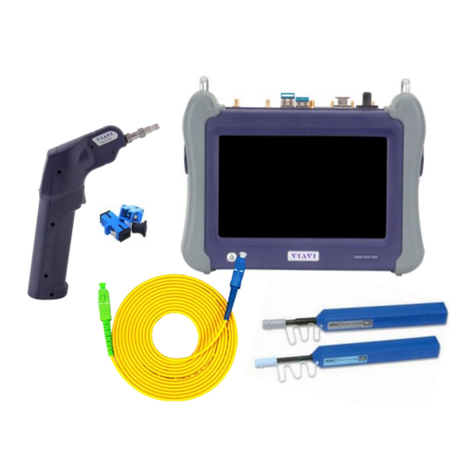
Viavi
Viavi T-BERD/MTS 5800 Quick Card User Guide
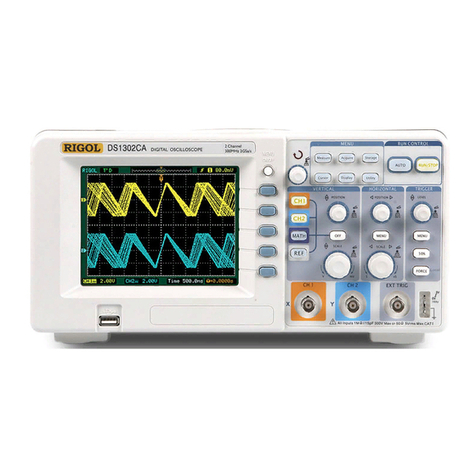
Rigol
Rigol DS1000 Series Programming guide
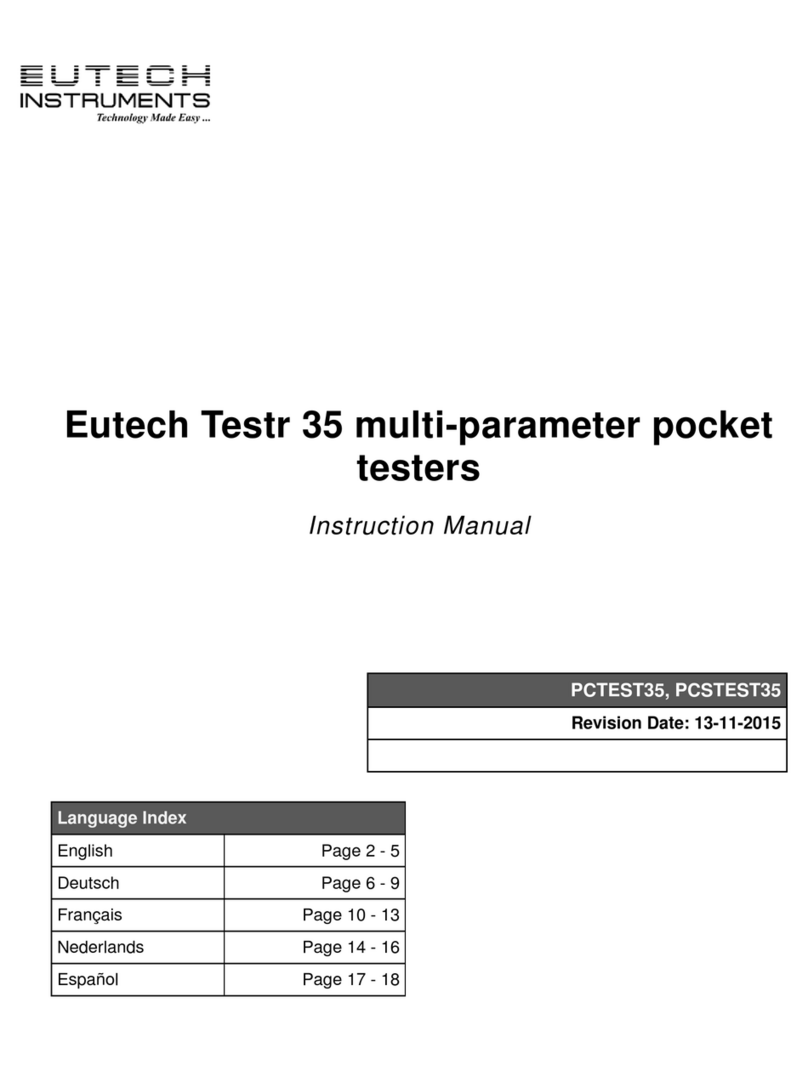
EUTECH INSTRUMENTS
EUTECH INSTRUMENTS Testr 35 Series instruction manual
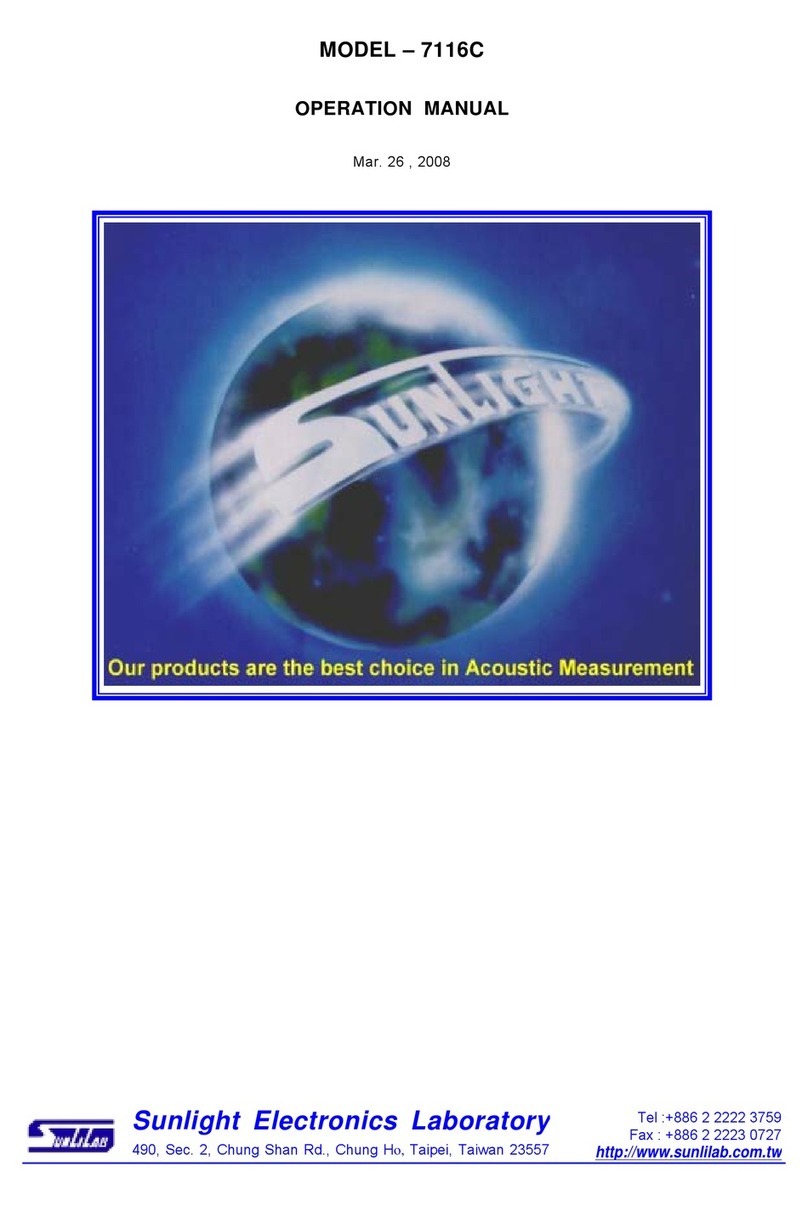
Sunlight Electronics Laboratory
Sunlight Electronics Laboratory 7116C Operation manual
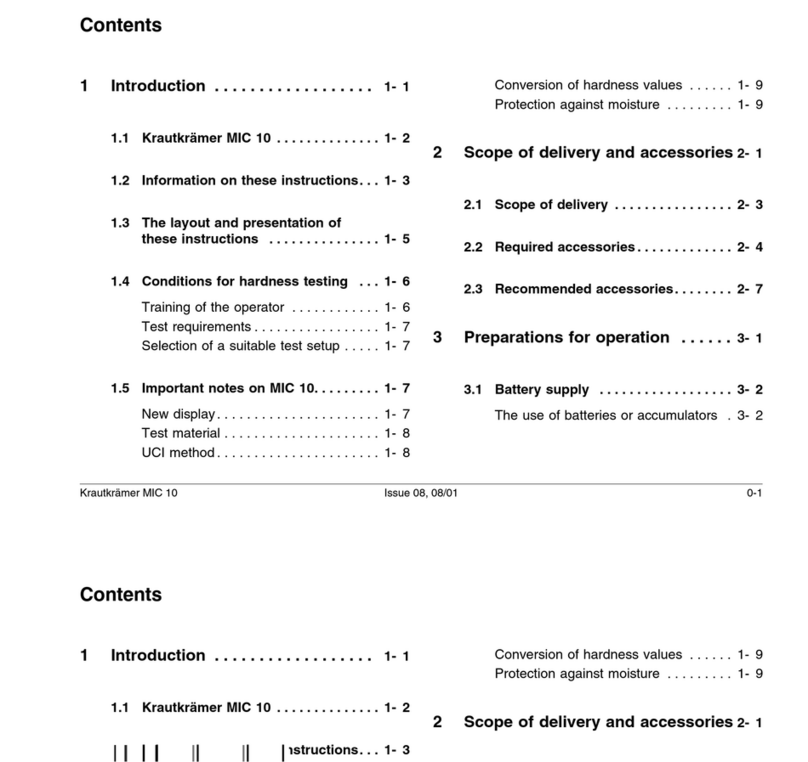
Branson
Branson Krautkramer MIC 10 user manual

SW-Stahl
SW-Stahl 21010L instruction manual

